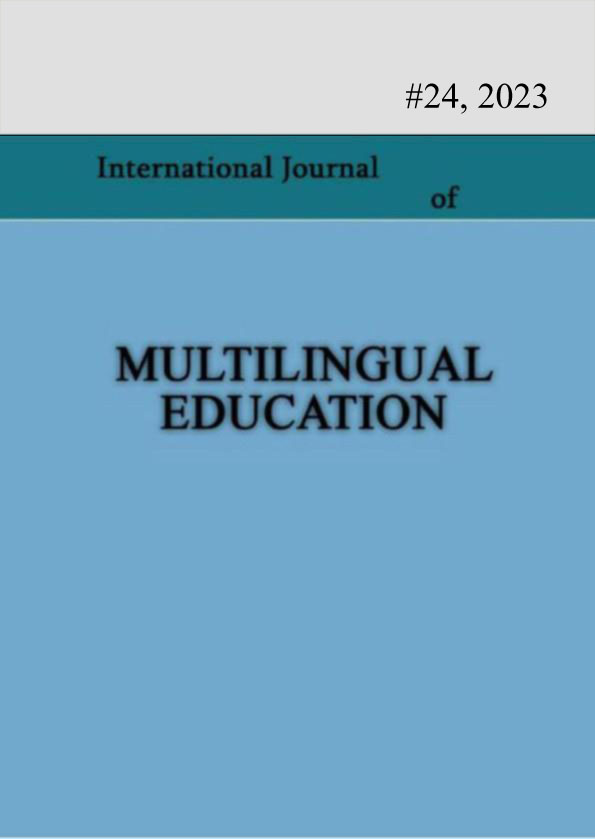Multilingualism in Germany and the Role of Submersion and Immersion Programmes
Keywords:
Multilingualism, immigration, SLE, submersion, immersionAbstract
As a result of recent immigration, Germany has become a multilingual country with a great need for multilingual education. In the first part of the article the roles of minority and immigrant languages in Germany are discussed. Some demographic changes are briefly
outlined as well as the implications for the general education system. In the second part, submersion and immersion approaches are discussed and evaluated in the context of the German school system. It is argued that classroom interactional competence is a crucial factor in promoting students‘ linguistic skills.
References
Baker, C. (2011).Foundations of Bilingual Education and Bilingualism. Bristol: Multilingual Matters.
Carrasquillo, A.L. & Rodriguéz, V. (2002).Language Minority Students in the Mainstream Classroom. Clevedon: Multilingual Matters.
Coelho, E.(2012).Language and Learning in Multilingual Classrooms: A Practical Approach. Multilingual matters:
Bristol.Elsner, D., & Keßler, J. U.(2013).“Bilingual Approaches to Foreign Language Education in Primary School”. In: Bilingual Education in Primary School: Aspects of Immersion, CLIL, and Bilingual Modules. Tübingen, p. 16-27.
Genesee, F.(2008). “Early Dual Language Learning”. Online available at: https://www.ryerson.ca/mylanguage/images/Genesee.pdf
Gibbons, P. (2002). Scaffolding Language, Scaffolding Learning. Teaching Second Language Learners in the Mainstream Classroom. Portsmouth NH.
Heinemann.Klewitz, B.(2017).Scaffolding im Fremdsprachenunterricht. Tübingen: Narr.
Massler, U.,& Burmeister, P. (2010). CLIL und Immersion.Fremdsprachlicher Sachfachunterricht in der Grundschule. Braunschweig.
Westermann.Piske, T. (2013).“Bilingual Education: Chances and Challenges”. In: Bilingual Education in Primary School: Aspects of Immersion, CLIL, and Bilingual Modules. Tübingen, p. 28-40.
Piske, T.(2006). “Zur Entwicklung der Englischkenntnisse bei deutschsprachigen Immersionschülerinnen und -schülern im Grundschulalter”. In: Schlüter, Norbert (ed.): Fortschritte im Frühen Fremdsprachenunterricht. Ausgewählte Tagungsbeiträge Weingarten 2004. Berlin: Cornelsen, p. 206-212.
Piske, T.,& Burmeister, P.(2008). “Erfahrungen mit früher Immersion an norddeutschen Grundschulen. In: Schlemminger, Gerald (ed.). Erforschung des bilingualen Lehrens und Lernens. Forschungsarbeiten und Erprobungen von Unterrichtskonzepten und -materialien in der Grundschule. Baltmansweiler: Schneider Verlag Hohengehren, p. 131-148.
Valdés, G. (1998). The World outside and inside School: Language and Immigration Children.In: Educational Researcher 27 (6), p. 4-18.
Walsh, S. (2014). Classroom Interaction for Language Teachers. Alexandria,Va: TESOL International Association.Weitz, M.,& Andreas R. (2010). “German children’s L2 English vocabulary in bilingual kindergarten programmes in Germany: Why do the children’s scores differ so strongly from each other?” In: Christiane Bongartz & Jutta Rymarczyk (eds.): Languages across the Curriculum. Frankfurt: Lang, p. 51-70.
Wode, H. (2009). Praxis Frühkindliche Bildung: Frühes Fremdsprachenlernen in bilingualen Kindergärten und Grundschulen.Braunschweig: Westermann.
Zydatiß, W.(2000). Bilingualer Unterricht in der Grundschule. Entwurf eines Spracherwerbskonzepts für zweisprachige Immersionsprogramme.Ismaning: Max Hueber Verlag.
Downloads
Published
How to Cite
Issue
Section
License
Copyright (c) 2023 Mathias Hutz

This work is licensed under a Creative Commons Attribution-NonCommercial 4.0 International License.
Copyright (c) - Authors who publish with this journal agree to the following terms: Authors retain copyright and grant the journal the right of first publication with the work simultaneously licensed under a Creative Commons Attribution-Noncommercial 4.0 International License, which allows others to share the work with an acknowledgement of the work's authorship and initial publication in this journal. Authors are permitted and encouraged to post their work online (e.g., in institutional repositories or on their personal website) prior to and during the submission process, as it can lead to productive exchanges, as well as earlier and greater citation of published work (see The Effect of Open Access). Authors may enter into separate, additional contractual arrangements for the non-exclusive distribution of the journal's published version of the work (e.g., post it to a repository or publish it in a book), with an acknowledgement of its initial publication in this journal.

